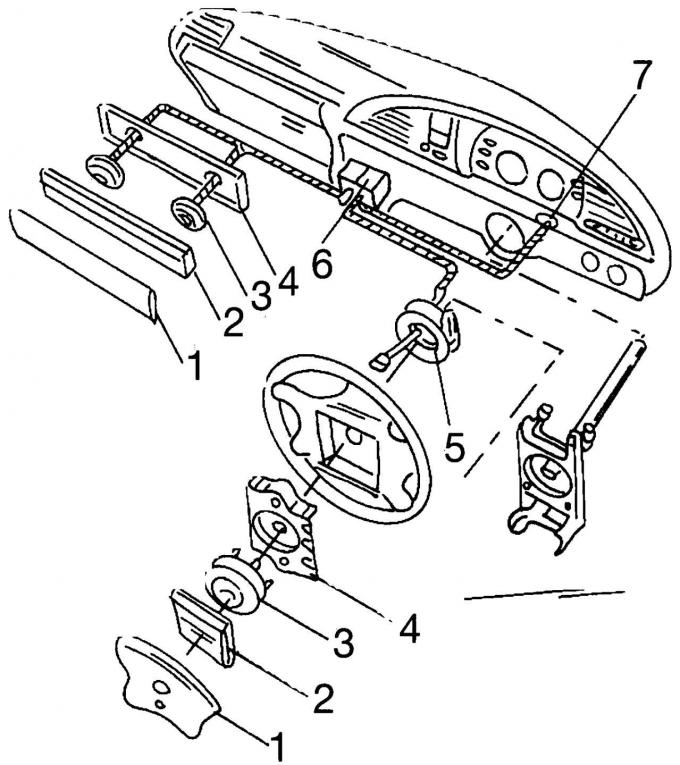
Pic. 19. The main elements of the airbag system: 1 - cover; 2 - airbag; 3 - actuator; 4 - metal container; 5 - «hourly» spring; 6 - electronic control unit; 7 - signal lamp
The operation of the entire system, including diagnostic elements, is controlled by an electronic control module based on sensor signals. One of them generates a signal during acceleration and deceleration, and the other perceives only decelerations. Both sensors are connected in series, so if they both detect a sudden deceleration greater than the set value, the airbag system will deploy. Electronic control module 6 (pic. 19) serves to control the operation of the system. If damage is detected, the warning light 7 flashes or stays on to warn the driver that the system is malfunctioning. If the system is OK, the lamp is on for 4 seconds after the ignition is turned on, and then goes out.
So-called «hourly» spring 5 transmits the necessary signals between the electronic module and the airbag module on the driver's side. The spring is mounted on the steering column switch holder and consists of fixed and movable parts that are connected to each other by a twisted MyIar tape with current-carrying tracks. The Mylar tape can be wound and unwound while turning the steering wheel, on which the moving part is mounted, so that electrical contact is maintained between the electronic control unit and the airbag module at any time. «Hourly» the spring simultaneously transmits electrical current for the horn and cruise control switches, if installed.
The airbag actuator is located in a metal container on which the folded airbag is located. The block is closed with a lid. The module is mounted on the steering wheel.
The actuator produces the necessary amount of non-toxic gas to inflate the airbag. On the driver's side, one actuator 3 is used, on the passenger's side next to the driver, two. Airbag 2 on the driver's side is almost round, on the passenger's side it matches the shape of the instrument panel. The cover 1 on the driver's side is firmly connected to the metal container 4 and cannot be separated from it. It is equipped with a certain number of invisible break points, thanks to which the airbag deploys quickly if the system is triggered.
In the event of a frontal collision, the following occurs in the airbag system:
- both sensors detect sudden
If both sensors are closed at the same time, then an electric current flows to the actuator, which activates the ignition of the gas;
- when gas is burned in a metal container, nitrous carbon dioxide is formed. The gas during airbag inflation is filtered and cooled;
- the gas-filled airbag breaks the cover and quickly unfolds in front of the passenger. The whole process takes place in a matter of fractions of a second;

Pic. 20. Airbag after gas release
- after filling, the gas is pushed out through the holes in the material. The airbags deflate immediately and look as shown in fig. 20. They can be easily moved to clear the passage.
Warnings
1. Airbags contain a flammable, but non-explosive, solid substance, so they will not explode in an accident or fire.
2. The steering wheel, steering column and airbag material do not get hot after an accident. «Smoke», dissipated in the air when the pillows are triggered, is not toxic, since it is talc or starch that the pillow is treated with.
3. Disconnecting the battery will deactivate the airbag system.
Visitor comments